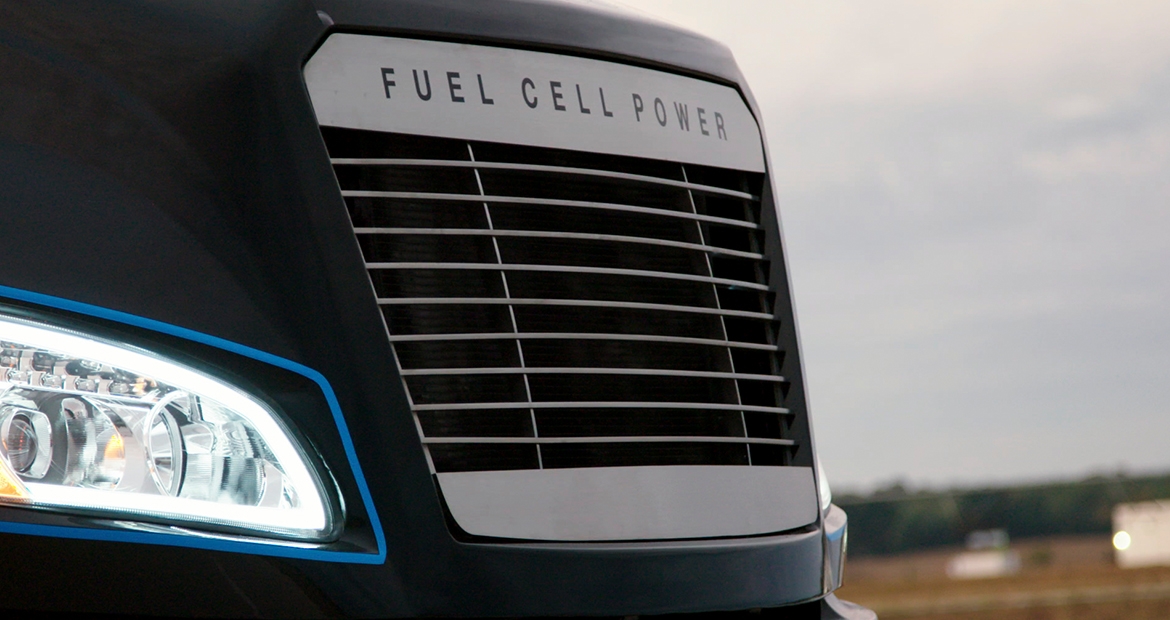What is a fuel cell?
By Katherine de Guia, Communications Specialist - New Power

Fuel cells aren’t new. In fact, the first reference to hydrogen fuel cells appears in 1838 in the December issue of The London and Edinburgh Philosophical Magazine and Journal of Science. Almost 200 years later, the world is recognizing fuel cells as a key technology to unlocking a carbon-neutral future.
Here is what they are, how they work and two fuel cell types that Cummins is investing in.
What is a fuel cell in simple terms?
Like batteries, fuel cells are energy converters – they use an electrochemical reaction to take the chemical energy stored in a fuel source and convert it to electricity. Unlike batteries, which contain a fixed supply of energy, fuel cells do not require recharging. As long as fuel is continuously supplied to the fuel cell, electricity, water and heat will be produced.
How does a fuel cell work?
A fuel cell is comprised of two electrodes and an electrolyte membrane. The electrodes are called a cathode and an anode, and they sandwich the electrolyte membrane between them. Within that system, a series of chemical reactions occur to separate the electrons from the fuel molecules to create energy.
The fuel, typically hydrogen, is fed into the anode on one side while oxygen is fed into the cathode on the other. At the anode, the hydrogen fuel molecules are separated into protons and electrons that will travel different paths toward the cathode. The electrons go through the electrical circuit, creating the flow of electricity. The protons travel through the electrolyte to the cathode. Once at the cathode, oxygen molecules react with the electrons and with the protons to create water molecules.
A fuel cell is a clean energy source with the only byproducts being electricity (power), heat and water. A single fuel cell alone only produces a few watts of power; therefore, several fuel cells can be stacked together to create a fuel cell stack. When combined in stacks, the fuel cells’ output can vary greatly, from just a few kilowatts of power to multi-megawatt installations.
What fuels can be used in fuel cells?
Fuel cells offer flexibility in the fuel type that can be used. While hydrogen is the most common fuel source for fuel cells (hence the common name, hydrogen fuel cells), hydrogen-rich fuels such as natural gas and ammonia are also viable fuel sources.
Hydrogen: When produced using renewable electricity – like solar, wind and hydropower – hydrogen is completely decarbonized and produces zero emissions. Hydrogen fuel cells (i.e. fuel cells that are fueled by hydrogen) produce power, heat and water and release no carbon dioxide or other pollutants into the air.
Natural gas: As widespread production of green hydrogen is still in progress, natural gas is currently the most-used fuel to power fuel cells. In this case the fuel cells are not completely emission-free, but they do offer significantly lower emissions than other fuels, like oil and coal.
Ammonia: Ammonia is most used in agriculture as fertilizer. However, in recent years, several companies have been working to develop green ammonia. Green ammonia is made with hydrogen that comes from water electrolysis powered by alternative energy, making it another option for a low-carbon fuel.
What types of fuel cells is Cummins investing in?
There are six types of fuel cells that are under development, each primarily classified by the kind of electrolyte they employ. Each type of fuel cell has its own advantages, limitations and potential applications. Out of the six, Cummins has recognized the potential in two types of fuel cells – proton exchange membrane fuel cells and solid oxide fuel cells - and has invested in the advancement of their technologies and their application.
Proton exchange membrane (PEM) fuel cells: Also referred to as polymer electrolyte membrane fuel cells, this type of fuel cell uses a polymer electrolyte and operates at lower temperatures of around 80 degrees Celsius. PEM fuel cells are more suitable for mobile and back-up power applications due to their high-power density and quick start-stop capabilities.
Solid oxide fuel cells (SOFCs): SOFCs use a hard, non-porous ceramic compound as their electrolyte and operate at high temperatures, as high as 1,000 degrees Celsius. This type of fuel cell is most suitable for stationary applications because it is highly efficient and fuel flexible. In addition, waste heat may be harnessed and reused to increase the overall system efficiency.
Why invest in fuel cells?
Already leaders in PEM electrolyzers that produce green hydrogen through electrolysis, we are working on making green hydrogen more readily available for future use in fuel cells. Cummins was awarded a U.S. Department of Energy grant for the advancement of SOFCs and have seen our fuel cells successfully support the operation of battery electric vehicles.
Fuel cells may predate the beginning of Cummins, but we are wasting no time discovering how to advance their technology to create a zero-emission future.
Author Profiles
Katherine de Guia, Communications Specialist - New Power
Communications Specialist - New Power
Related Tags